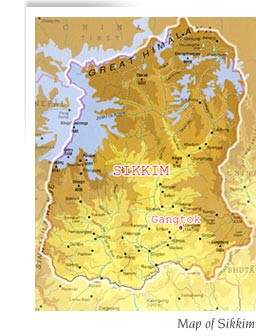 |
||
Physical Features The major mountain peaks of Sikkim are; Khangchendzonga-8,846 m, Jonsang-7,444 m, Talung-7,351 m, Kabru-7,338 m, Siniolchu-6,887 m, Pandim-6,691 m, Rathong-6,680 m Koktang-6,148 m, and Simvo-6,811 m. Sikkim’s two major rivers are the Teesta and the Rangeet. The turbulent Teesta, which has its source at the Chho Lhamu lake in the Tibetan Plateau is an unseeming little stream at first but gradually swells into a raging river as more tributaries converge into it’s path as it snakes through deep mountain valleys into the plains of Bengal. The gentler Rangeet has its source at the Rathong Glacier south of the Khangchendzonga massif. It meets with the Teesta at the valley dividing Sikkim and Bengal. There are numerous perennial lakes in Sikkim among which, Khechiperi, Gurudongmar, Chho Lhamu, Changu and Menmetsho are some of the more scenic. Climate Summers are extremely humid though not necessarily hot as temperatures vary according to altitude. In the lower and middle hills (Gangtok, Darjeeling, Kalimpong) the maximum temperatures range between 25 and 28° C. Down in the deep river valleys it can get stuffy but is never unbearably hot. Winters are relatively cold at night but pleasant during the day. In the lower and middle hills (Gangtok, Darjeeling, Kalimpong), night temperatures average 5° C, and day temperatures hover around 15° C. The alpine region of course becomes very chilly, and temperatures remain well below freezing except during moments when sunlight can seep in through the clouds. The Monsoon winds strike Sikkim between late May and early June, and there is incessant rain all across the state till late September. Around July and August, torrential downpours sometimes last for several days at a stretch. Gangtok has an annual rainfall of 325 cm. Vegetation The temperate forests have an interesting variety of trees and include oak, chestnuts, maple, birch, magnolia and rhododendron to name a few. Dendrobium orchids, from the giant hookeriana straddling the yokes of tall trees to the tightly-clustered densiflorum that flowers in a bunch the size of a baseball, can be seen in bloom during summer. In the soft humid soil amidst moss and shrubs are several terrestrial species, and includes several varieties of Paphiopedilum, the exotic ‘ladies slipper’. And up in the cool temperate reaches where the earth gives way to granite, there is larch, fir, juniper and more rhododendrons. Here in the summertime, the meadows come alive with myriads of wildflowers. |
||
 |
||
|
Branch
Office:-Speed Holidays pvt.ltd. National Highway, Deorali, Gangtok - 737
102 Sikkim, India . |

 Geography of Sikkim
Geography of Sikkim